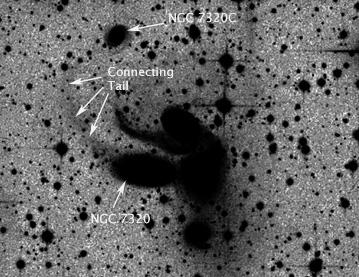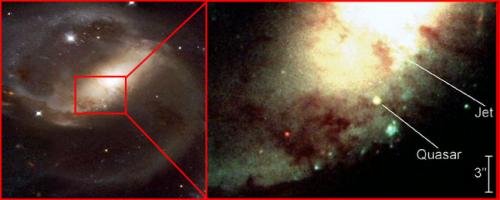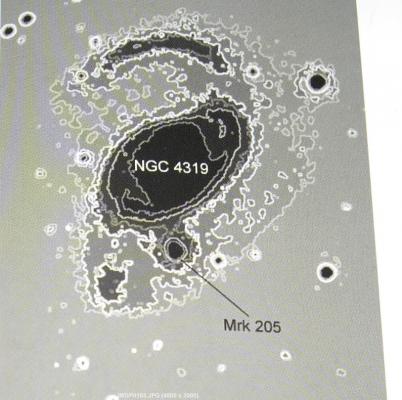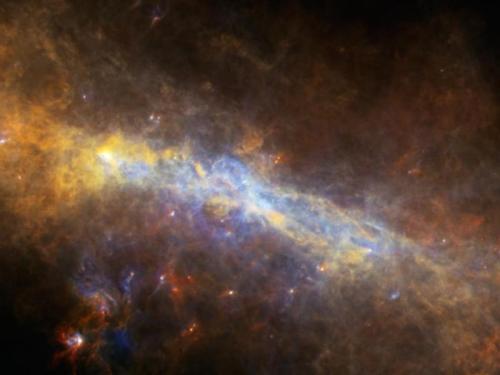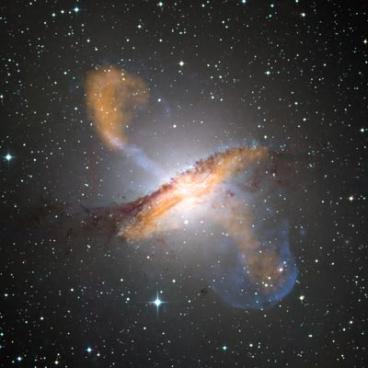-
Posts
90 -
Joined
-
Last visited
Content Type
Profiles
Forums
Events
Everything posted by EMField
-
I am not sure it is a steady state or expanding universe. I think it is simply a universe with no end that is in constant motion. There is no such thing as stationary anywhere in the universe, or a beginning point or edge or end to it. Such finite words applied to the universe have no meaning. How do you comprehend "everything" when no matter how far you could possibly travel there was only more? You can be sure the edge is not 14-20 billion light-years away, that is only the distance we can observe through all the intervening dust and plasma. According to relativity no matter where you were in the universe you would observe the same thing regardless of your velocity. So if one was on a highly red-shifted quasar and red-shift is due to velocity, then the quasar would appear normal to me, but all other objects would be redshifted depending on distance. So from a quasar, the Milky-way would appear to be highly red-shifted. Plasma red-shift depending on electron density much better explains relativity.
-
Plasma is only one aspect of it, do not forget what makes the plasma a plasma. But your Big Bang can no longer rely on red-shift = distance. It is an inherent affect of the plasma itself. Let us see what wiki has to say: http://en.wikipedia....a_%28physics%29 "Plasmas are by far the most common phase of matter in the universe, both by mass and by volume. All the stars are made of plasma, and even the interstellar space is filled with a plasma, albeit a very sparse one." Indeed, observations show that this plasma is so sparse that it blocks 70% of edge on galaxies because in the galaxies themselves it already blocks 50% of the light. http://www.space.com...nly-bright.html Again theory does not meet observations. "Quasineutrality of a plasma requires that plasma currents close on themselves in electric circuits. Such circuits follow Kirchhoff's circuit laws and possess a resistance and inductance. These circuits must generally be treated as a strongly coupled system, with the behavior in each plasma region dependent on the entire circuit. It is this strong coupling between system elements, together with nonlinearity, which may lead to complex behavior. Electrical circuits in plasmas store inductive (magnetic) energy, and should the circuit be disrupted, for example, by a plasma instability, the inductive energy will be released as plasma heating and acceleration. This is a common explanation for the heating that takes place in the solar corona. Electric currents, and in particular, magnetic-field-aligned electric currents (which are sometimes generically referred to as "Birkeland currents"), are also observed in the Earth's aurora, and in plasma filaments." http://en.wikipedia....rkeland_current "Auroral Birkeland currents carry about 100,000 amperes during quiet times and more than 1 million amperes during geomagnetically disturbed times." Space sure sounds neutral to me, how about you? And yet Einstein devised his theory of relativity on a static universe, and does not even agree with you about the existence of Black Holes. http://www.cscamm.um...hwarzschild.pdf So, I can trust him or trust you, hmmm, which do I choose? As a matter of fact please compare Schwarzschild metric with the one listed in wiki (or any modern textbook), tell me if they are the same??? http://en.wikipedia....rzschild_metric They just hide the evidence against it in other places you are not likely to venture to: http://en.wikipedia.org/wiki/Anisotropic "Physics Cosmologists use the term to describe the uneven temperature distribution of the cosmic microwave background radiation. There is evidence for a so-called "Axis of Evil"[/url] in the early Universe that is at odds with the currently favored theory of rapid expansion after the Big Bang.
-
Yah debunked, you mean unanswered. http://arxiv.org/abs/astro-ph/0401420 : http://adsabs.harvar...APS..APR.K1019B : http://vixra.org/pdf/1105.0010v1.pdf But that might not fit your theory so just discard it like normal. Long debunked as in a NASA approved report in 2011? Or long debunked as in LIGOS unsuccessful search for gravitational waves? Or perhaps those darn elusive WIMPS? Lol, you just keep believing that, but NASA tends to agree with those people. http://www.nasa.gov/...atmosphere.html "Beyond Earth's protective atmosphere and extending all the way through interplanetary space, electrified particles dominate the scene. Indeed, 99% of the universe is made of this electrified gas, known as plasma. " And as for your models NASA has this to add: "We need models to help predict hazardous events in the belts and right now we are aren't very good at that." So yah, you just keep believing in those models that predict nothing correctly.
-
The matter is already there, it exists in vast clouds of dust and plasma, clouds so vast and dense you can but barely peer 13 Billion light-years into it. http://www.space.com/5348-view-universe-suddenly-bright.html Dust and plasma in the ISM so thick that it hides 70% of edge on galaxies because the dust around them is so thick they are already 50% dimmer. There needs no creation of non-existing matter. They are shifted to the red due mostly to the electron density of the stuff they are made of, plasma, as has been demonstrated in actual laboratory experiments, not just theory as some only have, and the further one goes out the younger is the light reaching us, and hence the redder is this light. Now, since red-shift is clearly the electron density of plasma, then newly ejected but close quasars will have the same redshift as older but further away quasars when you add in this dust so thick it hides 70% of edge on galaxies. If you can comprehend what that imports to this theory among Dark Matter, Dark Energy and the list goes on. So when you get the mass calculations corrected, let me know what they say and we can have scientific discussions. And don't forget to add some more mass when you finish adding that blocked by dust, you can add that blocked by light. http://www.jpl.nasa.gov/news/features.cfm?feature=2287
-
I don't expect to ever see this sprinkling of fairy dust Black Holes, or it's accompanying Dark Matter or Dark Energy. I do expect that a few forces that already exist and are already explained will be mistaken for these entities, has been and will continue to be until NASA soon produces the data that tells you what this already existing force is that you mistake for these things. It already has in the above article, you just can't connect the dots because you include it in one theory (micro) and exclude it in the other (macro). And to this day you still wonder why you can not make a unified theory.
- 11 replies
-
-1
-
I am showing the quasars he wanted to see that are just as close as the galaxies 1) that one is in front of and 2) that the others are connected to by filaments. The torus image is an infrared image of the center of the Milky-Way. Maybe it sounds like plama as 99% of space is plasma? http://www.nasa.gov/mission_pages/rbsp/news/electric-atmosphere.html NASA seems to be thinking the current theories on space must not be very good ones scince in their own words: "We need models to help predict hazardous events in the belts and right now we are aren’t very good at that." and " But life on Earth is substantially different from, well, almost everywhere else. Beyond Earth's protective atmosphere and extending all the way through interplanetary space, electrified particles dominate the scene. Indeed, 99% of the universe is made of this electrified gas, known as plasma." Personally I can't wait for the data to start coming in, how about you?
-
-
Where is the black hole in the above image? I can see entirely through the plasma torus, for that is what it is (PLASMA). There is no BH absorbing the x-rays emitted from the other side of the torus. I understand the general public understands little about plasma, as well as most cosmologists. Strange since 99.99% of the universe is plasma, so one would think plasma physics study might be a good idea, but hey, if those ideas you have about plasma work so well, more power to you! Apparently even NASA realizes how little theory actual meets observation: "We need models to help predict hazardous events in the belts and right now we are aren't very good at that. RBSP will help solve that problem." http://www.nasa.gov/...atmosphere.html So now for the first time we will soon find out just how plasma behaves in space. I for one am looking forward to those results. Let's see how well that neutral theory pans out.
- 11 replies
-
-1
-
Pretty firm grounding, like the same firm grounding as LIGO's non-detection of gravitational waves, or other non-detection of WIMP's? That kind of firm scientific grounding? Please, show me an image of this evidence you have that proves the matter does not originate from inside this so called event horizon? Because what do we see when we gaze into the heart of a galaxy?
- 11 replies
-
-1
-
And yet observations show those so called older galaxies are exactly the same as galaxies today. Theory only fits if you ignore half the evidence. http://adsabs.harvard.edu/abs/1994A%26A...289..121R http://www.astro.uu.se/vinter/bwd1_eng.html The same stars in older galaxies are found in younger galaxies. Theory does not meet observations.
-
And yet so called galaxies at extreme distances from us, yet vastly younger according to theory, have the same composition of elements you see in stars that are close and vastly older. This does not support the idea of an expanding universe from a beginning, but an infinite steady state universe that has always been and will always be. If the universe began 14 billion years ago and the light I receive from a galaxy 13 billion year ago is composed of the same elements in existence in galaxies today, then the theory of stellar evolution can not be correct.
-
http://phys.org/news...black-hole.html As one can see the theory of Black Holes does not match observation or theory. Nothing can escape but the ocassional atom or particle. "Seen up close and personal, a black hole surely is capable of the occasional lapse, allowing a particle or even a whole atom to escape. But looking at the hugeness of a black hole across the vast distance of space, it definitely appears all consuming; always taking and never giving, to us appearing as if nothing, not even a photon could ever escape it's clutches. That's how you reconcile the two viewpoints." Look at an image of every galaxy claimed to harbor a Black Hole. There are continuous streams of ejected matter visible across the vast distance of space, in opposition to all consuming. The very article shows a image of one that defies the very explanation used to explain the two explanations in opposition to each other. And somehow the proof that Hawking Radiation has never been discovered is proof that the atoms escape occasionally. Maybe there is a fourth definition that applies to all of them. Black holes do not exist. And if photons can not escape a BH, then how does gravity get out and affect anything since it also travels at the speed of c?
- 11 replies
-
-1
-
There is no missing mass and hence no need for Dark Matter or Dark Energy. http://www.space.com...nly-bright.html Not only are the galaxies they can see twice as massive as thought because of the dust gathered around them, but in deep field images one of two explanations are available. Either interstellar dust is blocking us from seeing 70% more edge on galaxies (already half as bright as face on), or the majority of galaxies are face on to us. The second is about as unlikely as is red-shift = speed and distance and plot to the Finger of God plot. A slight majority of face on galaxies should be the average norm in the local galactic clusters. But to assume 70% of them do likewise in a 360 degree sphere around our galaxy is absurd. The interstellar medium (dust and plasma) is obscuring 70% more edge on galaxies because they were already half as bright. Not only can the age of the Universe not be known (as it cannot be seen), the amount of matter within it cannot be known. Therefore, the entire school of thought about "missing mass" is erroneous and false as there cannot be a discrepancy in "size versus matter observed" because 1) size of the Universe is unknown because its boundaries cannot be seen directly or indirectly 2) observed matter and mass cannot be what is actually there in totality because of obscuring dust -not because of there being too little matter in "existence" 3) extrapolation of the Universe's age based upon its size, matter, and "redshifts" from a "Big Bang" cannot be known. Moreover, Hubble "deep field" photographs, at various wavelengths, are not actually seeing the "deep field" implied in the press releases because: 1) the "deep field" stops short of what is actually beyond it due to the impossibility of the instruments being able to see beyond it (if anything, whenever you see --ever again-- the term "Hubble deep field" go ahead and accept that what is being seen is merely the local neighborhood of celestial objects, not the "edge of time" panoramas that NASA and others allege it to be) 2) so-called "at the edge of time" quasars are in actuality embedded, relatively near, close, and associated with "parent galaxies" of lower redshifts (remember, as the light ages its redshift decays to lower values, making quasars actually new objects and not "distant" ones -they are in all likelihood very close objects in the so-called "deep field" --which, as stated previously, must be actually close because the "true" "deep field," to the so-called "edge of time," cannot ever be seen or detected as it is obscured). http://www.jpl.nasa....fm?feature=2287 Then add some more mass by the underestimation of the number of smaller stars to large stars in the galaxies we can observe that are not obscured by this dust and one begins to see the problem of the missing mass is not that it isn't there, it is that it is hidden by dust and lost in the brightness of closer galaxies that we can observe. And remember the results are only sensitive for "The ultraviolet images are sensitive to somewhat small stars three times or more massive than the sun" even though the discrepancy shows up for larger stars, they still have not counted the stars of the Sun's mass or less that the original math developed in the 1950's relies on.



